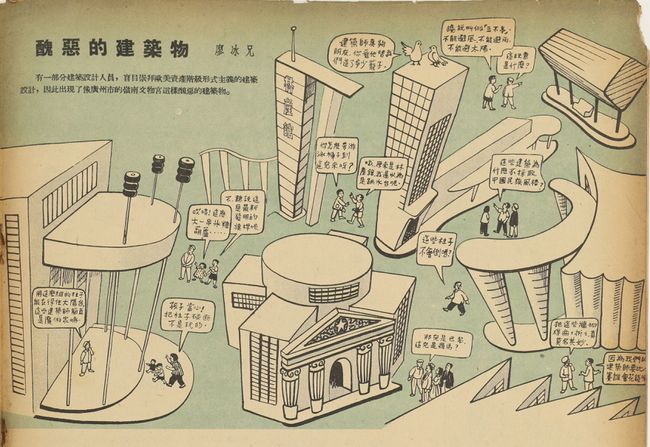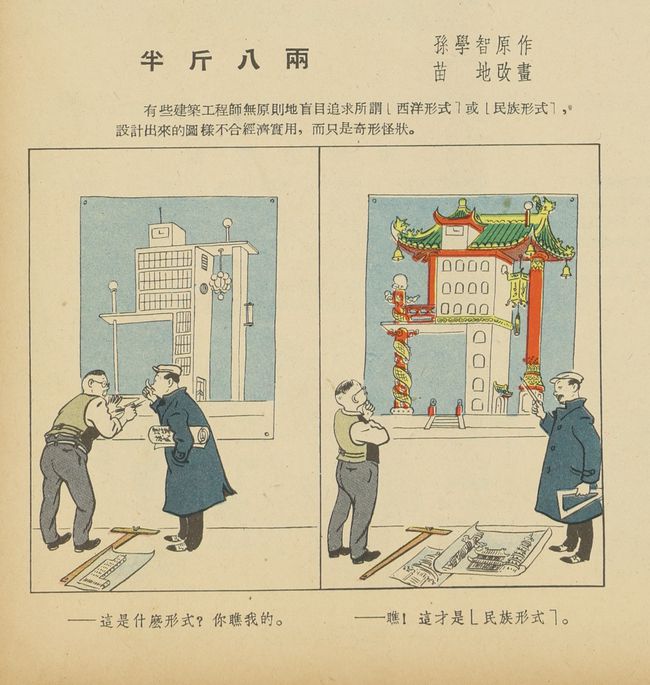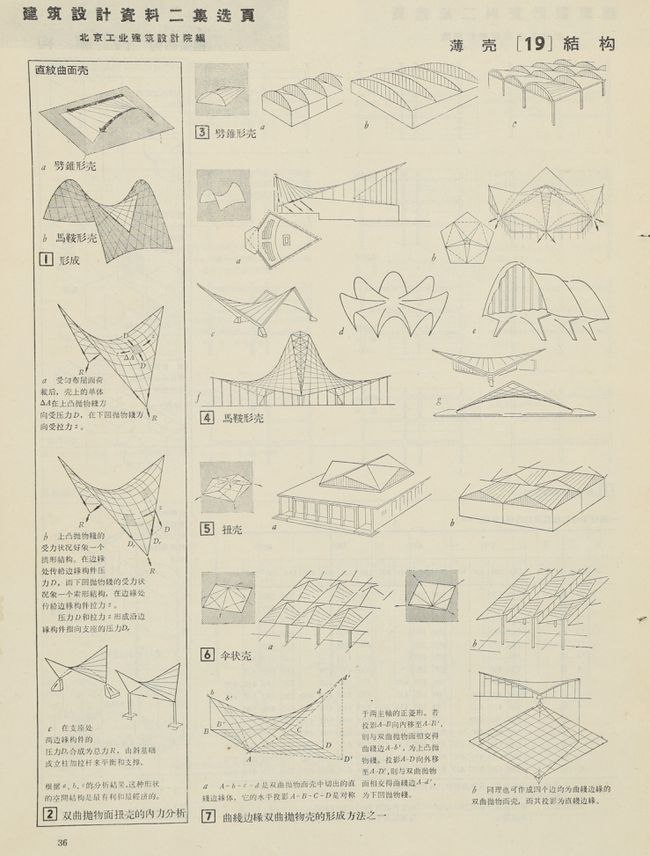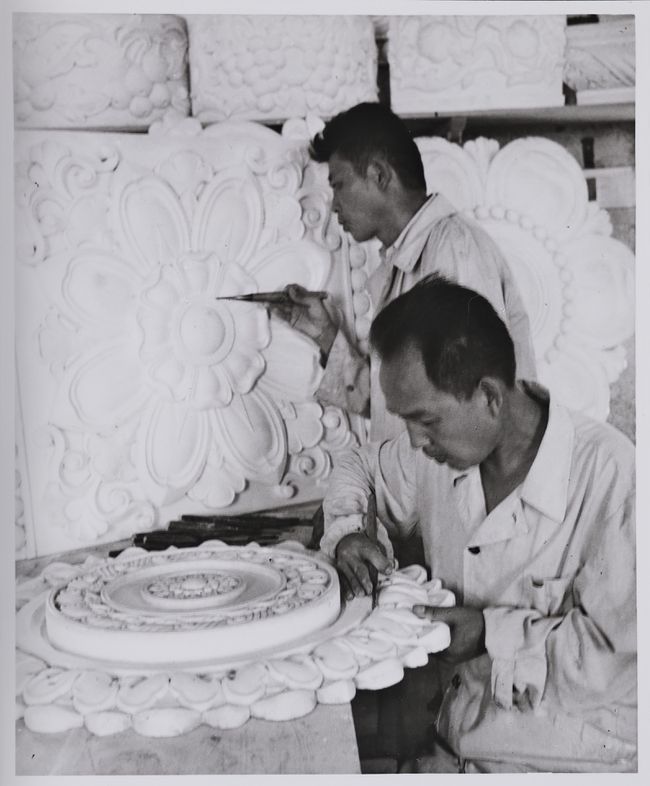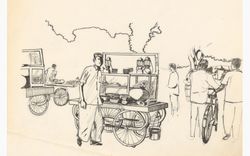“Function, economy, and (when possible) beauty”
Shirley Surya introduces How Modern
How Modern: Biographies of Architecture in China 1949-1979 is open in our Main Galleries from 20 November 2025 to 5 April 2026
How Modern: Biographies of Architecture in China, 1949–1979 is at once a question and a proposition. It is primarily a historiographical exercise that attends to the ambiguous criteria used to assess the “modern” in China’s architectural development. Between the founding of the People’s Republic of China in 1949 and the implementation of Reform and Opening Up policies in 1979, architecture played a key role in shaping China’s vision of socialist modernity. Driven by shifting political strategies, architects helped rebuild cities, transform the countryside, develop industry and infrastructure, innovate materials and structural design, and shape the forms and spaces for the new socialist nation—commonly referred to as New China.
Chinese Communist Party leaders including Chairman Mao (centre), Premier Zhou Enlai, and Beijing’s mayor Peng Zhen viewing a model of Beijing’s Tiananmen Square and its surroundings, ca. 1954, photograph in Jianzhu sheji shinian, 1949–1959 [Ten Years of Architectural Design, 1949–1959] (Ministry of Architecture Engineering of the People’s Republic of China, 1959). Southeast University Library at the School of Architecture
Even so, historians and practitioners have long perceived the development of modern architecture in this period as stunted, in some cases questioning if it occurred at all. They attribute this lapse to the demise of the architect’s professional autonomy, which they see as resulting from the shift from “independent” practice in Republican China to a nationalized and collectivized model under New China’s proletarian autocracy. The change from market-driven production to focusing on heavy industries also seemingly led to a lower quality of design, while explorations of modernist formalism were hindered by political dogma prioritizing a socialist realist “national style” rooted in classical forms. In assessing that a Euro-American model of modern architecture had begun to flourish in Republican China from the 1920s only to be abruptly stopped in 1949, critics rely on a specific historiographical framework of modern architecture that prioritizes notions of professional independence, novelty, progress, and well-known stylistic tropes such as transparency, fluidity, the use of industrial materials, minimalism, flat roofs, and rejection of traditional forms.
“Ugly architecture. Some architects blindly worship the formalist styles of Western bourgeois design. As a result, grotesque and reactionary buildings like the Lingnan Cultural Palace in Guangzhou have appeared.”
Manhua 44 (1954). CL.2017.4.36, M+, Hong Kong
“Equally Bad. Some architects, lacking principles, blindly pursue the so-called ‘Western style’ or ‘national style.’ The designs they produce are neither economical nor practical—only strange and grotesque in form.”
(left) “What kind of style is that? Look at
mine!”
(right) “Look! This is the ‘national style’!”
Manhua 53 (1955). CL.2017.4.44, M+, Hong Kong
Still, there remain limits to assessing architectural production under the PRC’s specific sociopolitical conditions, which differed substantially from the Euro-American contexts in which the Modern Movement was initially conceived. Even if scholars have recently called for a more inclusive and global concept of “situated modernism,” expanding on the geographies and circumstances that gave rise to modern architecture outside of Europe and North America, socialist realist architecture is still considered as radically anti-modernist and connected to totalitarian policies rather than democratic principles.1 However, these historiographical views are framed by an East-West, capitalist-socialist dichotomy, and privilege a Euro-American conception of modernism associated with the values of market economies. In the case of China, they often ignore local and regional priorities and references, the flows and commingling of multiple economic and cultural systems, and an extended historical view of the PRC’s first three decades, which were marked by a quick succession of reform policies with both astounding and devastating consequences.
-
Sarah Williams Goldhagen, “Coda: Reconceptualizing the Modern,” in Anxious Modernism. Experimentation in Postwar Architectural Culture, ed. Sarah Williams Goldhagen and Rejean Legault (The MIT Press and Canadian Centre for Architecture, 2000), 305–306. ↩
The first decade of the PRC focused on economic transition and agrarian restructuring. The New Democracy period (1949–1952) laid the groundwork for postwar reconstruction, promoting land reform and a mixed economy to boost China’s agricultural and industrial development. Supported by ideologies as well as assistance from the Soviet Union, the First Five-Year Plan (1953–1957), led by Chairman Mao and Premier Zhou Enlai, further consolidated China’s economic independence through mass industrialization. The Great Leap Forward (1958 1962) developed heavy industries through building vast infrastructure and mass mobilizing of resources in rural areas, in particular organizing collectivized labour in Peoples’ Communes—an operation that occurred so quickly and on such a massive scale that led to devastating famine and economic crisis. This demanded a brief period of economic adjustment (1961–1965) to rectify consequences of the Great Leap Forward, which involved balancing the ratio between agricultural and industrial output, and restoring farmers’ enthusiasm and initiative. Unfortunately, improvements from the adjustment were suppressed by an increasingly anti-rightist movement that led to the Great Proletarian Cultural Revolution (1966–1976), a radicalized political campaign launched by Chairman Mao and his allies to reassert their authority and renew adherence to the party line by eliminating perceived bourgeois elites through class warfare. This led to a widespread cultural rejection of elitism, technical innovation, material excess, and architecture, which was understood as reflecting China’s “Four Olds.” After the death of Chairman Mao in 1976, Chinese Communist Party leaders recommitted to the Four Modernizations—goals previously planned by Premier Zhou Enlai in the 1960s to develop agriculture, industry and science, technology, and defence, but halted by the Cultural Revolution. This was in line with efforts to strengthen and expand engagement with international partners during the period known as Reform and Opening Up (1978–1979).
Over these three decades marked by rapid and often contradictory policy shifts, the architecture profession was subjected to constant political flux. While architects were called to work in newly established state-led institutes to rebuild the nation after the founding of the PRC, constructing everything from state monuments to factories, infrastructure, towns, and housing, by the Cultural Revolution they were branded as “intellectuals” with some sent to labour camps for thought reform. They had to quickly adjust to changing, sometimes competing slogans that sought to capture the profession’s political and economic mandate: “socialist content and national form” (1953), “function, economy and (when possible) beauty” (1955), “greater, faster, better, and more economical” (1958), “self-reliance, arduous fight” (1964), and finally “liberate the mind, prosper in creation” (1979). Considering such oscillating conditions, How Modern does not use the Cold War framework of analysis to denounce or glorify Chinese communism, nor does it justify a particular political system or deny social grievances, like the famine caused by the Great Leap Forward or major injustices resulting from the Cultural Revolution. Even so, such traumatic events have led to historical amnesia or sweeping statements of how we understand Mao-era China. Scholarship on the period between 1949 and the mid-1960s has also been overshadowed by studies on the Cultural Revolution.
How Modern aims to diversify narratives and histories across these three decades by attending to their cycles of transformation and their impact on architectural production and practice. It re-evaluates how architects navigated policy shifts and professional demands during the first three decades of the PRC against the broader “generative principles” of the Modern Movement, which account for modernism’s diverse and widespread appropriation across historical periods and geopolitical contexts in the twentieth century.1 How was political power exercised to facilitate social betterment? How did a new culture of inventiveness emerge from employing architectural precedents? And how were the spirit of the times and ideals of progress embodied through use of industrial technology? In identifying how principles of the Modern Movement were accepted, rejected, or adapted in New China, this project invites a more expanded, yet also fundamental, approach to modern architecture, one going beyond narratives centring the figure of the architect as a free agent or stylistic form of a building. Instead, it conceives modern architecture in terms of its inventiveness and public good, and the ways it exercised purpose, economy, and a strong political will even under limiting conditions. To this end, it foregrounds the broader mission of modern architecture to shape a more humanized built environment.2
-
Goldhagen, “Coda: Reconceptualizing the Modern,” 301–303; Hilde Heynen, “Engaging Modernism,” in Back From Utopia: The Challenge of the Modern Movement, ed. Hubert-Jan Henket and Hilde Heynen (0I0 Publishers, 2002), 386–387. ↩
-
Sarah Williams Goldhagen, “Something to Talk about: Modernism, Discourse, Style,” in Journal of the Society of Architectural Historians 64, no. 2 (2005): 141–167. ↩
Bringing together documentation of architectural production under the PRC across diverse media– journal articles, propaganda posters, cartoons, drawings, and historical photographs from private and institutional holdings–alongside oral histories by designers, artists, and archivists, How Modern illuminates specific social and cultural microhistories of modern architecture that are not evident in purely textual historical sources. These “social biographies” of architectural projects and the various agents involved in their production, consumption and mediation—the state, officials, architects, workers, and inhabitants—frame the nationwide project of building socialism (shehui zhuyi jianshe 社会主义建设) not just as a top-down, ideological phenomenon, but as a process worked out in everyday practices that engaged the senses and creative will of citizens. The selected cases reflect the plurality and tensions that characterized architectural production in this period: between agency and control, scarcity and abundance, policy and practice, competition and collaboration, and craft and standardization, as well as between the impact of domestic and foreign relations. Characterized by material and technical inventiveness, continuities and discontinuities with social, economic, and political inclinations, and direct and indirect influences from within and beyond the Eastern Bloc, How Modern challenges singular narratives of architectural practice in New China as monolithic, hermetic, and autocratic. In doing so, it also offers a more textured picture of modernism as it was conceived, realized, and experienced.


